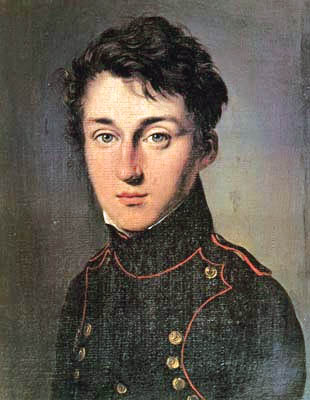SOME PIONEERS IN AIR ENGINE DESIGN

Sadi Carnot
(aged 17)
In 1824 Sadi Carnot (1796-1832) published, in Paris, a small book entitled :
REFLECTIONS
SUR LA
PUISSANCE MOTRICE
DU FEU
SUR LES MACHINES
PROPRES A DEVELOPPER CETTE PUISSANCE
The book sold for 3 Francs but apparently hardly any one purchased a copy, although it received one long and excellent review in the Revue Encyclopedique a Journal which covered all branches of literature.
Carnot established the principle which governs the operation of all heat engines. He defined the closed cycle of operations now known as the Carnot cycle.
When considering a machine for developing the motive power of heat through the use of elastic fluids (gases or vapours) Carnot laid down the following principles :
- The temperature of the fluid should be made as high as possible, in order to obtain a great fall of caloric, and consequently a large production of motive power.
- For the same reason the cooling should be carried as far as possible.
- It should be so arranged that the passage of the elastic fluid from the highest to the lowest temperature should be due to increase of volume; that is, it should be so arranged that the cooling of the gas should occur as spontaneously as the effect of rarefaction.
- The limits of the temperature to which it is possible to bring the fluid primarily, are simply the the limits of the temperature obtainable by combustion; they are very high.
- The limits of cooling are found in the temperature of the coldest body of which we can easily and freely make use; this body is usually the water of the locality.
In considering the choice between gas, in the form of atmospheric air, or vapours in the form of steam Carnot examined advantages and disadvantages of air :
- It presents, as compared with vapour of water, a notable advantage in that, having for equal volume a much less capacity for heat, it would cool more rapidly by an equal increase of volume. (This fact is proved by what has already been stated). Now we have seen how important it is to produce by change of volume the greatest possible changes of temperature.
- Vapours water can be formed only through the intervention of a boiler, while atmospheric air could be heated directly by combustion carried on within its own mass. Considerable loss could be prevented, not only in the quantity of heat, but also in its temperature. This advantage belongs exclusively to atmospheric air. Other gases do not possess it. They would be even more difficult to heat than vapour of water.
- In order to give to air great increase in volume, and by that expansion to produce a great change of temperature, it must first be taken under a sufficiently high pressure; then it must be compressed with a pump or by some other means before heating it. This operation would require a special apparatus, an apparatus not found in steam™engines. In the latter, water is in a liquid state when injected into the boiler, and to introduce it requires but a small pump.
- The condensing of the vapour by contact with the refrigerant is much more prompt and much easier than is the cooling of air. There might of course, be the expedient of throwing the latter out of the atmosphere, and there would be also the advantage of avoiding the use of a refrigerant, which is not always available, but it would be requisite that the increase of the volume of the air should not reduce its pressure below that of the atmosphere.
- One of the gravest inconveniences of steam is that it cannot be used at high temperatures with out necessitating the use of vessels of extraordinary strength. It is not so with air for which there exists no necessary relation between the elastic force and the temperature. Air, then, would seem more suitable than steam to realize the motive power of falls of caloric from high temperatures; perhaps at low temperatures steam may be more convenient. We might conceive even the possibility of making the same heat act successively on air and vapour of water. It would be only necessary that the air should have, after its use an elevated temperature, and instead of throwing it out immediately into the the atmosphere, to make it envelop a steam boiler, as if it issued directly from a furnace. The use of atmospheric air for the development of the motive power of heat presents in practice very great, but perhaps not insurmountable difficulties. If we should succeed in overcoming them, it would doubtless offer a notable advantage over vapour of water. As to the other permanent gases, they should be absolutely rejected. They have all the inconveniences of atmospheric air, with none of its advantages. The same can be said of other vapours than that of water, as compared with the latter.
Carnot's work was translated into English by R. H. Thurston (who was the first president of the A.S.M.E) entitled Reflextions on the Motive Powers of Heat, Click on this link for a PDF copy



